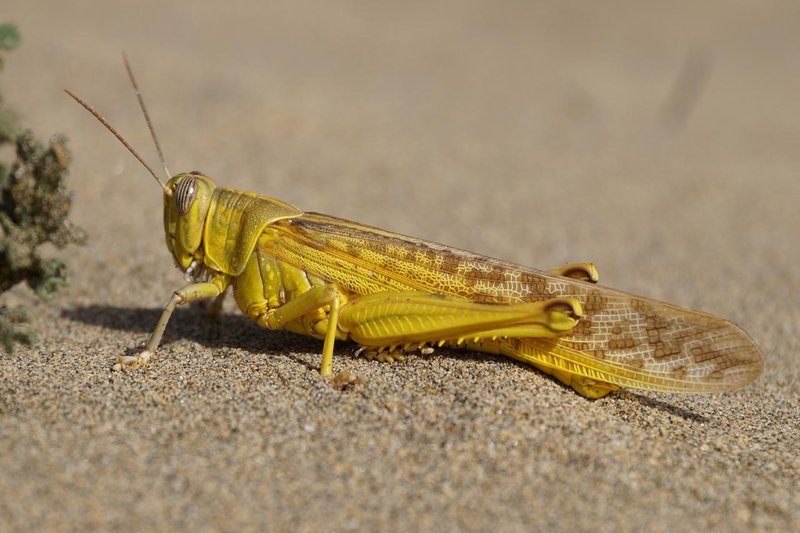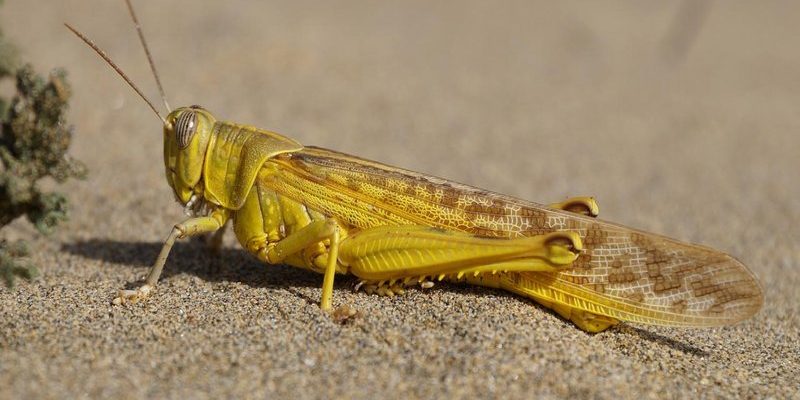
Imagine a creature so incredible that it can change from a solitary existence to marching in a vast horde, devouring everything in its path. That’s the Desert Locust for you! These fascinating insects are much more than just pests; they are a prime example of how nature can flip the script in the blink of an eye. When conditions are right, a single Desert Locust can transform into a part of a swarm that can cover hundreds of square miles, causing devastation to crops and plants.
The term “Desert Locust” usually brings to mind images of bustling swarms that can darken the skies. However, these insects are not always in swarm mode. They have a unique life cycle and behavior that allows them to shift between solitary and gregarious phases depending on environmental conditions. Understanding this transformation can help us appreciate their role in the ecosystem and the challenges they pose to agriculture.
So, let’s dive into the world of the Desert Locust—where they live, what they eat, and why their behavior can create both awe and anxiety for those who encounter them.
What Is a Desert Locust?
The Desert Locust (Schistocerca gregaria) is a species of short-horned grasshopper that can be found in arid and semi-arid regions. They are known for their adaptability and ability to swarm, leading to significant impacts on agriculture and food supplies. While they primarily inhabit areas across Africa, the Middle East, and parts of Asia, their swarming behavior can lead them to travel over vast distances in search of food.
These locusts are usually about 2 to 8 centimeters long, depending on their age and phase. In their solitary phase, they are less colorful and typically have a more subdued appearance. However, when environmental conditions encourage swarming, they can develop bright yellow and green colors. This change not only helps in camouflage during swarming but also signals the potential for danger to their predators.
As social insects, Desert Locusts communicate with each other through pheromones, which are chemical signals that trigger their swarming behavior. When food becomes abundant, they can breed rapidly, leading to a population explosion that can seem almost overnight. This ability to multiply quickly is one of the reasons they have gained a fearsome reputation.
Life Cycle and Development
The life cycle of the Desert Locust is quite fascinating and can be divided into three main stages: egg, nymph (also called “hopper”), and adult. The entire cycle can be completed in as little as three months, though it varies depending on environmental conditions.
Egg Stage: Female locusts lay their eggs in the sandy soil during periods of favorable conditions. One female can lay anywhere from 30 to 100 eggs at a time. These eggs typically hatch within two weeks if the weather is warm and moist, which is crucial for their survival.
Nymph Stage: After hatching, the young locusts, or hoppers, emerge. They start out as pale, wingless nymphs. As they grow, they molt several times—about 5 to 6 times—before reaching adulthood. During this stage, they can remain solitary or begin to swarm, depending on population density and food availability.
Adult Stage: Once they reach maturity, usually after about 3 to 4 weeks, locusts develop wings and can start breeding. Adult Desert Locusts can live for several months under ideal conditions and continue to reproduce rapidly, contributing to the formation of swarms. This quick succession of breeding is what makes them a major agricultural threat.
Habitat and Distribution
Desert Locusts thrive in a variety of habitats, primarily found in arid and semi-arid regions. They are most commonly spotted in North Africa, West Africa, and parts of the Middle East. However, their distribution can be quite dynamic due to their migratory nature, which allows them to travel long distances in search of suitable conditions.
Ideal Conditions: These locusts prefer warm climates with sparse vegetation. They often live in sandy or loamy soils where they can lay their eggs. Areas that receive sporadic rainfall are also attractive to them, as these environments can lead to a flourishing of plants, providing ample food for their growing populations.
Interestingly, Desert Locusts can also be found in regions adjacent to deserts, where grasslands and scrublands abound. Their ability to adapt to different environments is key to their survival. During periods of drought, they may become dormant, waiting for the right conditions to arise before they spring back into action, sometimes in massive swarms.
Diet and Feeding Behavior
Desert Locusts are primarily herbivores and have a voracious appetite. Their diet mainly consists of grasses, leaves, and crops. A single locust can consume its weight in food each day, which translates to aspirations for larger swarms. When conditions are right, their feeding can quickly escalate into a full-on agricultural crisis.
Feeding Behavior: Locusts are known for their swarming behavior, which allows them to cover large areas and efficiently consume crops. When in swarms, they can travel hundreds of kilometers in just a few days. Their feeding not only affects local agriculture but can also have long-term implications for food security in affected regions.
When they are in the solitary phase, Desert Locusts feed much less aggressively. In this state, they are more focused on survival rather than rapid multiplication. However, once they shift into the gregarious phase, their feeding instinct sharpens, and they will latch onto any suitable vegetation, leading to extensive damage. Farmers often find their entire fields stripped bare after a locust swarm passes through.
Economic Impact
The economic impact of Desert Locust swarms can be staggering. Given their ability to consume large quantities of crops in a short amount of time, they pose significant threats to food security and agricultural economies. When swarms invade agricultural areas, they can lead to total crop failure, which devastates local farmers and communities.
Impact on Agriculture: In agricultural regions, a single swarm can consume as much food in one day as tens of thousands of people would need in a year. This not only leads to immediate food shortages but can also spike food prices drastically. Many countries that rely on agriculture face an uphill battle in combatting these infestations, leading to long-term economic challenges.
Moreover, the pressure to respond to swarms can drain financial resources, as governments and organizations must invest in mitigation strategies, including monitoring and control measures. These steps can be costly and may not always yield immediate results. Therefore, the Desert Locust is not just an environmental challenge; it’s an economic concern as well.
Control and Management
Controlling Desert Locust swarms is crucial in minimizing their impact on agriculture. Various strategies are employed to manage and mitigate swarms, ranging from chemical controls to integrated pest management practices. Early detection is key in preventing large-scale outbreaks. Organizations like the Food and Agriculture Organization (FAO) play an essential role in monitoring locust populations and providing timely alerts.
Pesticides and Biocontrol: In many cases, the use of pesticides is the primary method of control. However, it’s essential to use these chemicals responsibly to minimize harm to the environment and non-target species. Biocontrol approaches, such as introducing natural predators or pathogens, are also being explored as sustainable alternatives to chemical pesticides.
Community involvement is another critical aspect of control. Educating local farmers about monitoring methods and early signs of swarming can empower them to act quickly. This kind of grassroots awareness can make a real difference in reducing the size and impact of an outbreak.
Table of Interesting Facts about Desert Locusts
| Fact | Details |
| Scientific Name | Schistocerca gregaria |
| Size | 2 to 8 cm (0.8 to 3.1 inches) |
| Habitat | Arid and semi-arid regions, deserts, grasslands |
| Diet | Grasses, leaves, crops |
| Speed | Up to 16 km/h (10 mph) |
| Lifespan | Up to 3 months in ideal conditions |
The Desert Locust is a remarkable insect that embodies the unpredictability of nature. While they may seem like a mere agricultural nuisance, their life cycle and behavior are fascinating from both an ecological and economic perspective. Understanding how these creatures operate can help us better prepare for and manage their impacts. Whether they’re fluttering through the desert or swarming en masse, Desert Locusts remind us of the delicate balance between nature and human interests.
FAQ
What triggers the swarming behavior of Desert Locusts?
Swarming behavior in Desert Locusts is often triggered by environmental conditions such as heavy rainfall and the availability of food. When locust populations reach a certain density, they begin to exhibit gregarious behavior, leading to the formation of large swarms. These swarms can travel great distances in search of food and can quickly become a significant threat to agriculture.
How can farmers protect their crops from Desert Locusts?
Farmers can protect their crops from Desert Locusts through a combination of early detection and timely response. Regular monitoring for signs of locust activity is crucial. If a swarm is detected, farmers can use chemical pesticides or biological control methods to mitigate the infestation. Additionally, maintaining healthy crop diversity and implementing pest management practices can help reduce vulnerability to locust damage.
Are Desert Locusts harmful to humans?
Desert Locusts are not directly harmful to humans. They do not bite or sting, and their presence mainly poses a threat to crops and food security. However, large swarms can lead to significant agricultural damage, which indirectly affects human populations by increasing food scarcity and prices.
What is the lifespan of a Desert Locust?
The lifespan of a Desert Locust can vary depending on environmental conditions. Typically, they can live for up to 3 months, but those in swarms can sometimes live shorter lives due to factors such as predation and increased energy expenditure. Their life cycle is heavily influenced by food availability and weather conditions.
Do Desert Locusts have predators?
Yes, Desert Locusts do have natural predators. Birds, such as starlings and sparrows, are among the most significant predators of locusts. Additionally, other insects, like certain beetles and wasps, can also prey on them. Despite these predators, locust swarms can still thrive due to their rapid reproduction rates.
How do environmental conditions affect Desert Locust populations?
Environmental conditions play a crucial role in the population dynamics of Desert Locusts. Factors such as rainfall, temperature, and vegetation growth influence when and where locusts breed. Prolonged periods of favorable conditions can lead to population explosions, while droughts can cause populations to decline. Understanding these conditions can help in predicting and managing locust outbreaks.
Can Desert Locusts be controlled without pesticides?
Yes, Desert Locusts can be controlled through various methods other than pesticides. Integrated pest management strategies, which include biological control methods, habitat management, and community education, can be effective. For example, encouraging natural predators and using insect pathogens can help reduce locust populations sustainably.
What role does the Food and Agriculture Organization (FAO) play in locust management?
The FAO plays a critical role in monitoring and managing Desert Locust populations on a global scale. They provide early warning systems, coordinate research, and facilitate the sharing of information among countries affected by locust swarms. Their efforts aim to help mitigate the impacts of locust outbreaks on agriculture, food security, and rural economies.
What is the difference between solitary and gregarious Desert Locusts?
Solitary Desert Locusts tend to be more subdued in color and behavior, living independently and avoiding large groups. In contrast, gregarious locusts are more colorful and exhibit social behavior, forming large swarms. The transition from solitary to gregarious behavior is influenced by environmental factors such as population density and food availability, which triggers a change in their behavior and physical characteristics.
How often do swarms occur?
The frequency of Desert Locust swarms can vary widely. Swarming often occurs in cycles, influenced by climatic conditions and environmental factors. Some regions may experience swarms every few years, while others may go without for a decade. The unpredictability of these cycles makes understanding and monitoring Desert Locust populations essential for effective management.

